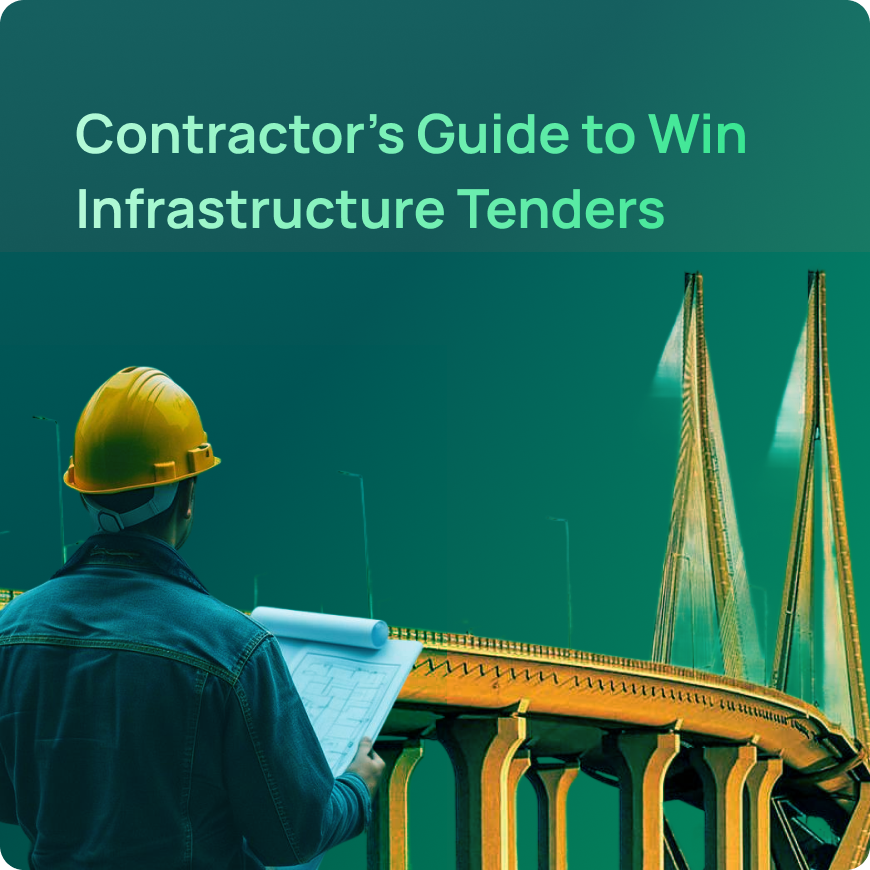Guide to Win Infrastructure Tenders in India
Learn how to win tenders for infrastructure projects, including NTPC tender, Railway tenders, NBCC tender, and Smart City Tender. Discover effective tender analysis strategies and the benefits of Tender AI analysis.

India is on the cusp of an infrastructure revolution. With the government’s National Infrastructure Pipeline (NIP) outlining a staggering ₹111 lakh crore ($1.4 trillion) investment by 2025, the opportunities for contractors are unprecedented. However, this boom also brings fierce competition. Every day, thousands of tenders are floated across critical sectors like roads, railways, and smart cities. For CXOs and business leaders in the infrastructure space, the challenge isn’t just finding opportunities—it’s winning them.
To consistently win tenders, a reactive, manual approach is no longer viable. Success in today’s landscape demands a strategic, data-driven methodology. This guide will walk you through a proven framework for navigating the complexities of infrastructure bidding. We’ll explore the nuances of key sectors, delve into the critical process of Tender Analysis, and reveal how leveraging Tender AI analysis can provide the ultimate competitive edge, helping you secure high-value contracts from authorities like NTPC, Indian Railways, NBCC, and the Smart Cities Mission.
Understanding Infrastructure Tenders: An Overview
At its core, an infrastructure tender is a formal invitation for contractors to submit a bid to execute a specific project. These projects form the backbone of a nation’s economy and include everything from highways and bridges to railway lines and technologically advanced urban centres.
Defining the Core Sectors:
- Roadway Tenders: These often fall under initiatives like the Bharatmala Pariyojana, focusing on constructing highways, expressways, and rural roads.
- Railway Tenders: Managed primarily by Indian Railways, these involve track laying, station modernization, electrification, and signalling projects.
- Smart City Tenders: These are part of the government’s ambitious Smart Cities Mission and involve integrating technology (IoT, data analytics, sustainable solutions) into urban infrastructure.

Key Authorities Floating Tenders:
Understanding the issuing authority is crucial as each has its unique standards, evaluation criteria, and focus areas.
- National Thermal Power Corporation (NTPC): An NTPC tender typically relates to the construction of power plants, ash dykes, and associated infrastructure, demanding high safety and engineering standards.
- Indian Railways: As one of the world’s largest railway networks, it floats a massive volume of Railway tenders daily, covering civil, mechanical, and electrical engineering.
- National Buildings Construction Corporation (NBCC): An NBCC tender focuses on project management consultancy and real estate development, including redevelopment of government properties and urban infrastructure.
- Smart Cities Mission: A Smart City Tender is floated by a city’s Special Purpose Vehicle (SPV) and seeks innovative solutions for urban problems, from intelligent traffic management to smart water grids.
Types of Tenders:
- Open Tender: Open to all eligible contractors, promoting maximum competition.
- Limited Tender: Invitation is sent to a limited number of pre-qualified contractors.
- Direct Negotiation/Single Tender: Awarded to a single contractor, usually for specialized work or in emergencies.
Step-by-Step Guide to Winning Infrastructure Tenders
Winning isn’t about bidding on every tender; it’s about strategically selecting the right ones and crafting a superior proposal. Here’s how you can systematize your success.
Step 1: Identifying the Right Opportunities
The first step is building a robust pipeline of relevant tenders. Chasing the wrong opportunity is a significant drain on time and resources.
Sources to Track:
- Government Portals: The Central Public Procurement Portal (CPPP) is the primary hub for central government tenders. The Government e-Marketplace (GeM) is another key platform.
- Authority-Specific Portals: For specialized contracts, monitor the official websites directly:
How to Shortlist Relevant Tenders: Manually sifting through thousands of tenders is inefficient. The goal is to quickly filter based on:
- Project Value: Does it align with your company’s financial capacity?
- Scope of Work: Does it match your core competencies and experience?
- Geographical Location: Do you have the logistical capabilities to operate in that region?
- Eligibility Criteria: Can you meet the pre-qualification (PQ) requirements?
Step 2: Tender Analysis – Decoding Tender Documents
Once you’ve shortlisted a tender, the real work begins. A thorough Tender Analysis is the foundation of a winning bid. This manual process involves meticulously reading through hundreds of pages of documents (NIT, BOQ, SOW, GCC, SCC) to extract critical information. A study by KPMG found that cost and time overruns are common in 85% of infrastructure projects, often stemming from risks missed during the initial analysis phase.
Checklist for Analyzing Road, Railway, and Smart City Tenders:
- Project Scope Clarity:
- Is the scope of work clearly defined? Are there ambiguities?
- What are the key deliverables and milestones?
- For Smart City Tenders, what are the specific technology requirements (e.g., IoT platforms, data standards)?
- Eligibility Criteria:
- Do you meet the financial turnover requirements?
- Do you have “similar work experience” as defined in the document?
- Are there specific machinery or personnel requirements?
- Technical and Financial Evaluation Parameters:
- What is the weightage given to the technical score vs. the financial score (e.g., 70:30, 80:20)?
- For Railway tenders, what are the specific RDSO standards or safety protocols mentioned?
- What are the payment terms, and how do they impact your cash flow?
- Identify all clauses related to penalties, liquidated damages, and warranties.
Step 3: Using Tender AI Analysis to Supercharge Your Bidding
The manual Tender Analysis process is not only time-consuming but also prone to human error. This is where technology becomes a strategic differentiator. Tender AI analysis automates the painstaking process of document review, allowing your team to make faster, more informed decisions.
Instead of your best engineers spending days reading documents, an AI-powered platform can process a 500-page tender in minutes, providing actionable intelligence. This frees up your team to focus on strategy and crafting a compelling proposal.
How AI Can Help You Win Infrastructure Tenders
Modern AI tools are designed to act as a co-pilot for your bidding team, offering unprecedented speed and accuracy.
- AI Tender Synopsis: Imagine getting a concise, one-page summary of a complex tender document in minutes. This tool extracts the most critical information—project scope, key dates, eligibility criteria, and financial requirements—allowing you to quickly assess if a tender is a good fit.
- AI Go/No-Go Analyser: This is a game-changer for strategic decision-making. The AI analyses your company’s profile (past projects, financials, capabilities) against the tender’s requirements and provides a data-backed recommendation on whether to bid (“Go”) or not (“No-Go”). This helps you focus your resources only on tenders you have a high probability of winning.
- AI Risk Analyser: This feature acts as your automated risk manager. The AI scans the entire tender document for potentially adverse or contradictory clauses related to penalties, liabilities, payment delays, and unclear specifications. By flagging these risks upfront, it allows you to address them in your bid or pre-bid queries.
- Pre-Bid Clarification: Ambiguities in tender documents can lead to costly assumptions. AI tools can automatically identify unclear clauses and help you draft precise questions for the tendering authority. As detailed in this guide on Pre-Bid Clarification, getting these doubts resolved officially is crucial for submitting a compliant and competitive bid.
By leveraging these AI capabilities, you transform your bidding process from a reactive, labour-intensive task into a proactive, data-driven strategy to win tenders.
Step 4: Strategic Preparation of Your Tender Bid
With insights from your AI-powered analysis, you can now craft a bid designed to win.
Creating Winning Proposals:
- Technical Proposal Preparation:
- Clearly outline your execution methodology.
- For an NTPC tender, detail your safety management plan. For a Smart City Tender, showcase your technology integration roadmap.
- Use 3D models, charts, and project timelines to make your proposal compelling and easy to understand.
- Financial Proposal Strategies:
- Your pricing should be competitive, not just the lowest. Use data from past projects and insights from the risk analysis to build a robust budget.
- Factor in all direct and indirect costs, including potential contingencies identified by the AI Risk Analyser.
- Ensure your Bill of Quantities (BOQ) is accurate and aligns perfectly with the tender’s requirements.

Sector-Specific Tips to Win Infrastructure Tenders
Winning Road Project Tenders
The road sector in India is booming, with the government aiming to build 60,000 km of world-class national highways by 2024. To win here, focus on:
- Compliance: Adherence to standards from the Ministry of Road Transport and Highways (MoRTH) and the National Highways Authority of India (NHAI) is non-negotiable.
- Quality & Safety: Highlight your quality control processes and a stellar safety record.
- Pitfall to Avoid: Underestimating logistical challenges in remote locations. Your plan must account for supply chain and resource mobilization.
Winning Railway Tenders
Railway tenders are known for their technical rigor and strict timelines, driven by the National Rail Plan for India - 2030.
- Technical Rigor: Deep knowledge of Research Designs and Standards Organisation (RDSO) specifications is essential.
- Historical Performance: Indian Railways places a high value on past performance. Showcase your successful completion of similar railway projects.
- Timeline Sensitivity: Railway projects are critical to national connectivity. Your proposal must demonstrate a credible plan to meet aggressive deadlines.
Winning Smart City Tenders
Success in a Smart City Tender hinges on demonstrating innovation. According to the Smart Cities Mission guidelines, projects must be scalable, sustainable, and citizen-centric.
- Innovation and Technology: Propose solutions that leverage IoT, data analytics, and sustainable materials.
- Collaboration: Show your ability to work with technology partners, urban planners, and local communities.
- Alignment with Mission Objectives: Your bid must clearly articulate how your project will improve quality of life, enhance sustainability, and drive economic growth, aligning with the core goals of the mission.

Case Studies: Real Examples of Successful Infrastructure Bids
- NTPC Tender Win: A mid-sized EPC firm was evaluating an NTPC tender for constructing an ash slurry disposal pipeline. The manual review suggested it was a standard project. However, the Tender AI analysis flagged a subtle clause linking penalties to the operational efficiency of the main power plant, a risk valued at crores. Armed with this insight, the firm addressed this risk directly in their technical bid and adjusted their financial model, ultimately winning the contract by submitting a more realistic and compliant proposal.
- Major Railway Tender Win: A large contractor was pursuing a high-value Railway tender for track doubling. The AI Go/No-Go Analyser initially flagged a “medium” probability of winning due to a mismatch in specific machinery requirements. Instead of abandoning the bid, the firm used this insight to immediately secure a lease for the required equipment and included the signed agreement in their bid, turning a weakness into a strength and securing the project.
- NBCC Tender Win: For an NBCC tender involving the redevelopment of a government housing complex, competition was intense. One bidder used an AI Tender Synopsis to quickly grasp the project’s emphasis on green building materials and energy efficiency. While others submitted standard proposals, this firm’s bid was tailored around sustainability, including LEED certification plans and energy-saving models. This alignment with NBCC’s modern construction ethos helped them score higher on the technical evaluation and win the tender.
Common Mistakes to Avoid in Infrastructure Tendering
- Incomplete Tender Analysis: Rushing the analysis and missing critical compliance or risk clauses is the #1 reason for disqualification or, worse, winning an unprofitable project.
- Underestimating Competition: Failing to analyse the competitive landscape and positioning your bid uniquely.
- Ignoring Compliance: Submitting a bid that doesn’t strictly adhere to the submission format, deadlines, or documentation requirements.
- Copy-Paste Bidding: Submitting a generic proposal that isn’t tailored to the specific needs and priorities of the issuing authority (e.g., submitting a road-focused bid for a highly technical railway project).

Future of Infrastructure Tendering: AI and Automation
The digital transformation of the infrastructure sector is accelerating. The future of bidding is not about replacing human expertise but augmenting it with powerful tools. The adoption of AI in the construction industry is projected to grow significantly, with a market size expected to reach $4.51 billion by 2026.
Tender AI analysis is moving from a “nice-to-have” to a “must-have.” AI-powered platforms will become central to the entire bidding workflow—from intelligent opportunity discovery and automated analysis to data-driven pricing and proposal generation. Firms that embrace this technological shift will not only improve their win rates but also build more resilient, profitable, and scalable businesses.
Conclusion
The journey to consistently win tenders in India’s dynamic infrastructure market is challenging, but the path is clear. It requires moving beyond traditional, manual methods and embracing a more strategic, technology-driven approach.
By mastering the fundamentals of each sector, conducting meticulous Tender Analysis, and leveraging the transformative power of Tender AI analysis, you can de-risk your bidding process, optimize resource allocation, and significantly increase your chances of securing profitable projects. In an era of intense competition, the contractors who adopt AI-powered insights won’t just participate in the infrastructure boom—they will lead it.